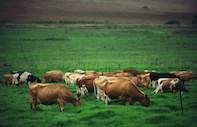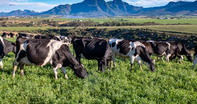The first aspect to look at when starting a dairy farm is choosing the right breed for your local conditions.

Is the climate warm or cold? Do you have good quality feed available, do you have housing for your cows and is there a lot of cattle diseases in the area. Choosing the right breed for dairy farming is important to ensure healthy animals, a good yield and strong offspring that will live long.
How to Choose a Breed

The breed to use for commercial production therefore depends on personal preferences, environmental factors such as climatic conditions, available feeds and milk end-products for example if you want to sell milk or want to make cheese.
For example, processors producing cheese prefer use milk high in milk solids (fat and protein) produced by Jersey cows. The high milk volumes produced by Holstein cows are more suited for liquid products, such as milk or yogurt.
Which Dairy Cattle Breed to Choose?
Most cows can be milked for household consumption but for commercial dairy farming in South Africa, there are four cattle breeds that are specialist dairy cows.
These are: Holsteins - from the original Dutch Friesian cow Ayrshires - from Scotland Jerseys - from the Jersey Isles between England and France Guernseys - from the Guernsey Isles between England and France Minor dairy breeds include Brown-Swiss and Milking Shorthorns.
Some European dual-purpose breeds, derived from the Simmental breed, are also currently being milked in South Africa. These include the Fleckvieh, Montbéliarde and Abondance from Germany, France and Italy, respectively.
Other available European breeds are the Normandé (from France) and Scandinavian Red breeds like the Swedish Red and Norwegian Red. In some countries, local breeds - mostly Zebu types are used for milk production.
The milk yield of cows from local breeds is lower than that of specialist dairy breeds but they tend to live longer. This is because of a better reproductive ability, being more robust, and better adapted to local conditions such as heat tolerance and a greater resistance to diseases.
Imported breeds require better living conditions, such as shade or housing facilities and better quality feeds. Because of adaptability problems crossbreeding between specialist dairy breeds and local breeds is becoming popular. For example, in New Zealand the Kiwi cow was developed through a system of criss-cross breeding using Holstein and Jersey sires (bulls).
By Dr Carel Muller